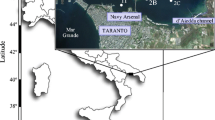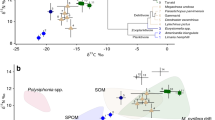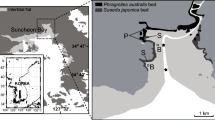Abstract
We have investigated the impact of shrimp farming waste on benthic invertebrates in a mangrove estuary in southern Thailand. Stable carbon and nitrogen isotope analyses were used to assess the contribution of aquaculture feed as a nutrient source for benthic invertebrates (fiddler crabs Uca annulipes, U. bengali, and U. forcipata) and to compare the organic origin of sediments in tributaries with and without a shrimp farm. The isotopic contributions of shrimp feed to crabs varied between the tributaries: in the tributary with the farm, the crabs had higher contributions from shrimp feed, whereas there was only a small contribution from aquaculture feed in crabs from the reference tributary. In contrast, the contribution of shrimp feed to the sediment did not differ between the tributaries, the contributions to sediments from aquaculture feed were, in general, quite low. Based on these results, we suggest that, in mangrove estuaries, changes in the food sources of several surface feeder invertebrates would be an effective indicator of the possibility that aquaculture waste was affecting the benthic ecosystem.


Similar content being viewed by others
References
Holmer M, Marba N, Diaz-Almela E, Duarte CM, Tsapakis M, Danovaro R (2007) Sedimentation of organic matter from fish farms in oligotrophic Mediterranean assessed through bulk and stable isotope (δ13C and δ15N) analyses. Aquaculture 262:268–280
Qian PY, Wu MCS, Ni IH (2001) Comparison of nutrients release among some maricultured animals. Aquaculture 200:305–316
Holmer M, Kristensen E (1992) Impact of marine fish cage farming on metabolism and sulfate reduction of underlying sediments. Mar Ecol Prog Ser 80:191–201
Karakassis I, Tsapakis M, Hatziyanni E (1998) Seasonal variability in sediment profiles beneath fish farm cages in the Mediterranean. Mar Ecol Prog Ser 162:243–252
Hargrave BT, Duplisea DE, Pfeiffer E, Wildish DJ (1993) Seasonal changes in benthic fluxes of dissolved oxygen and ammonium associated with marine cultured Atlantic salmon. Mar Ecol Prog Ser 96:249–257
Weston DP (1990) Quantitative examination of macrobenthic community changes along an organic enrichment gradient. Mar Ecol Prog Ser 61:233–244
Karakassis I, Hatziyanni E, Tsapakis M, Plaiti W (1999) Benthic recovery following cessation of fish farming: a series of successes and catastrophes. Mar Ecol Prog Ser 184:205–218
Primavera JH (1997) Socio-economic impacts of shrimp culture. Aquacult Res 28:815–827
Flaherty M, Karnjanakesorn C (1995) Marine shrimp aquaculture and natural resource degradation in Thailand. Environ Manag 19:27–37
Dierberg FE, Kiattisimkul W (1996) Issues, impacts, and implications of shrimp aquaculture in Thailand. Environ Manag 20:649–666
Takai N, Hirose N, Osawa T et al (2007) Carbon source and trophic position of pelagic fish in coastal waters of south-eastern Izu Peninsula, Japan, identified by stable isotope analysis. Fish Sci 73:593–608
Won NI, Kawamura T, Onitsuka T et al (2007) Community and trophic structures of abalone Haliotis diversicolor habitat in Sagami Bay, Japan. Fish Sci 73:1123–1136
Burford MA, Preston NP, Glibert PM, Dennison WC (2002) Tracing the fate of 15N-enriched feed in an intensive shrimp system. Aquaculture 206:199–216
Lojen S, Spanier E, Tsemel A, Katz T, Eden N, Angel DL (2005) δ15N as a natural tracer of particulate nitrogen effluents released from marine aquaculture. Mar Biol 148:87–96
Sara G, Scilipoti D, Mazzola A, Modica A (2004) Effects of fish farming waste to sedimentary and particulate organic matter in a southern Mediterranean area (Gulf of Castellammare, Sicily): a multiple stable isotope study (δ13C and δ15N). Aquaculture 234:199–213
Alongi DM, Sasekumar A (1992) Benthic communities. In: Robertson AI, Alongi DM (eds) Tropical mangrove ecosystems. American Geophysical Union, Washington D.C.
Kon K, Kurokura H, Hayashizaki K (2007) Role of microhabitats in food webs of benthic communities in a mangrove forest. Mar Ecol Prog Ser 340:55–62
Jacob U, Mintenbeck K, Brey T, Knust R, Beyer K (2005) Stable isotope food web studies: a case for standardized sample treatment. Mar Ecol Prog Ser 287:251–253
Phillips DL (2001) Mixing models in analyses of diet using multiple stable isotopes: a critique. Oecologia 127:166–170
Phillips DL, Gregg JW (2003) Source partitioning using stable isotopes: coping with too many sources. Oecologia 136:261–269
McCutchan JH, Lewis WM, Kendall C, McGrath CC (2003) Variation in trophic shift for stable isotope ratios of carbon, nitrogen, and sulfur. Oikos 102:378–390
Shinnaka T, Sano M, Ikejima K, Tongununui P, Horinouchi M, Kurokura H (2007) Effects of mangrove deforestation on a fish assemblage at Pak Phanang Bay, southern Thailand. Fish Sci 73:862–870
Shervette VR, Aguirre WE, Blacio E et al (2007) Fish communities of a disturbed mangrove wetland and an adjacent tidal river in Palmar, Ecuador. Estuar Coast Shelf Sci 72:115–128
Guest MA, Connolly RM, Lee SY, Loneragan NR, Breitfuss MJ (2006) Mechanism for the small-scale movement of carbon among estuarine habitats: organic matter transfer not crab movement. Oecologia 148:88–96
Guest MA, Connolly RM, Loneragan NR (2004) Carbon movement and assimilation by invertebrates in estuarine habitats at a scale of metres. Mar Ecol Prog Ser 278:27–34
Chong VC, Low CB, Ichikawa T (2001) Contribution of mangrove detritus to juvenile prawn nutrition: a dual stable isotope study in a Malaysian mangrove forest. Mar Biol 138:77–86
Lalli CM, Parsons TR (1993) Biological oceanography: an introduction, 2nd edn. Butterworth-Heineman, Oxford
Meziane T, Sanabe MC, Tsuchiya M (2002) Role of fiddler crabs of a subtropical intertidal flat on the fate of sedimentary fatty acids. J Exp Mar Biol Ecol 270:191–201
Clough BF (1992) Primary productivity and growth of mangrove forests. In: Robertson AI, Alongi DM (eds) Tropical mangrove ecosystems. American Geophysical Union, Washington, D.C.
Bouillon S, Dahdouh-Guebas F, Rao AVVS, Koedam N, Dehairs F (2003) Sources of organic carbon in mangrove sediments: variability and possible ecological implications. Hydrobiologia 495:33–39
Acknowledgments
The authors are grateful to T. Medej, S. Tanyaros, P. Wirachwong, H. Yahata, K. Suganuma, S. Sugiura, and the staff at the Faculty of Science and Fisheries in the Rajamangala University of Technology for their assistance with the fieldwork. Constructive comments on the manuscript from two anonymous reviewers, I. McTaggart, M. Sano, T. Yoshikawa, K. Ikejima, M. Horinouchi, and members of the Laboratory of Global Fisheries Science were much appreciated. We would like to thank E. Wada, F. Takatsu, M. Toyokawa, and K. Okamoto for technical support. Special thanks are expressed to the National Research Council of Thailand for the granting of permits to conduct this study in Thailand. The first author received financial support from a Research Fellowship from the Japan Society for the Promotion of Science for Young Scientists. The present work was supported by grants-in-aid for International Scientific Research from the Ministry of Education, Science, Sports and Culture of Japan (No. 10041160) and from the Japan Society for the Promotion of Science (No. 15255017).
Author information
Authors and Affiliations
Corresponding author
Rights and permissions
About this article
Cite this article
Kon, K., Kawakubo, N., Aoki, JI. et al. Effect of shrimp farming organic waste on food availability for deposit feeder crabs in a mangrove estuary, based on stable isotope analysis. Fish Sci 75, 715–722 (2009). https://doi.org/10.1007/s12562-009-0060-x
Received:
Accepted:
Published:
Issue Date:
DOI: https://doi.org/10.1007/s12562-009-0060-x




